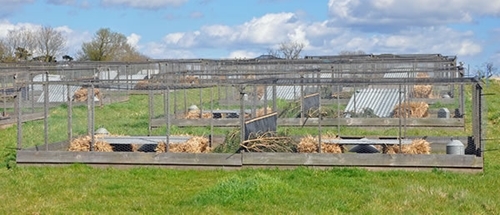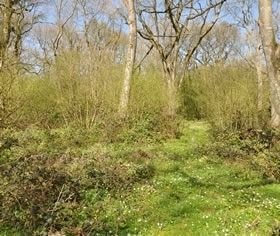By Roger Draycott, GWCT Head of Advisory
There has been a lot of discussion over the last couple of years about bag sizes and the increasing numbers of birds being released on some shoots. Data from the GWCT National Gamebag Census shows that the numbers of pheasants and red-legged partridges released each year continues to increase. Questions are being asked about what impacts all these birds may be having on other wildlife.

Good game management is good for wildlife
Many years of research at the GWCT has demonstrated that good game management can lead to significant knock-on benefits for wildlife. For example, woods managed for pheasants tend to support more songbirds and butterflies and they have more and wider woodland rides which benefits a wide range of wildlife.
It is active management of the woods that is key – opening up the woods to encourage the understorey shrubs - this type of work in the woods is much more common in woods where there is an interest in pheasant shooting.
Using game cover crops to hold and drive pheasants also benefits a wide range of declining farmland birds like yellowhammers, corn buntings and linnets to name a few. Effective predation control in the nesting season to encourage the wild birds to breed successfully can also benefit other ground nesting birds too – many of which, like lapwing and curlew are in serious decline.
Why the criticism?
So, if game management can be so good for wildlife, how come it comes in for criticism from certain quarters? Some conservationists raise concerns about the potential ecological impacts of releasing large numbers of pheasants into the countryside.
Are the pheasant poults eating the wildflowers in the woods or causing declines in butterflies by eating the caterpillars?
Is releasing large numbers of birds helping to support more foxes and buzzards locally by providing an abundant food source?
The reality is that most shoots are well run with a high level of environmental care in place. They have to be, otherwise the shoots would not be successful, especially in the long term, if the right habitats are not in place.
The foundation for good management on shoots is the Code of Good Shooting Practice which all shoots should be following. Of course, there are examples of bad practice and it is these ones which tend to hit the headlines.
Ensuring standards are met
But how can guns be reassured that the shoot they are thinking of buying a day at is delivering for wildlife and following best practice with respect to predator control and gamebird welfare?
Eating game is increasing in popularity, with game meat to the value of £106m consumed in the UK in 2015 compared to £98m in 2014 and the trend is expected to increase to £143 million by 2020. How can retailers and consumers be confident that the game they sell and consume is sourced from shoots that are looking after and indeed enhancing the natural environment?
 The GWCT now runs a shoot biodiversity assessment service to help farms, estates and game managers highlight where wildlife is benefiting from the shoot, identify any areas where there may be potential negative impacts and work with the shoot to improve them without affecting the running of the shoot.
The GWCT now runs a shoot biodiversity assessment service to help farms, estates and game managers highlight where wildlife is benefiting from the shoot, identify any areas where there may be potential negative impacts and work with the shoot to improve them without affecting the running of the shoot.
The assessment will also identify new opportunities where the shoot could benefit species or habitat conservation by tweaking some management. Ensuring that gamebird releasing and associated management are undertaken to a high standard, with demonstrable environmental benefits will be crucial to securing a long term sustainable future for game shooting and the GWCT shoot biodiversity assessment will help shoots achieve this.
GWCT Shoot Biodiversity Assessments - what's involved?
- A thorough on-site review of current game management and key game release areas to assess adherence to the Code of Good Shooting Practice and GWCT science based sustainable releasing guidelines.
- 2. A review of predation control practice to identify any training needs and to ensure all gamekeepers are following best practice guidelines.
- 3. Highlight areas where the shoot is already benefiting biodiversity and identify species and habitats on the shoot that could potentially benefit form game management.
- 4. Identify any areas where game management may be negatively impacting on species and habitats and work with the shoot to develop practical solutions and remedial action without negatively impacting on the running of the shoot.
What are the benefits of a GWCT Shoot Biodiversity Assessment?
- Reassurance for buyers of game shooting that shoots are following the Code of Good Shooting Practice and are either working towards or following best practice game management guidelines.
- A report for the shoot providing an independent assessment of the current situation and recommendations and action plan for future improvement of wildlife and habitats.
- Reassurance for consumers and retailers of game meat that game is sourced from sustainably-managed shoots.
- A certificate to demonstrate that the game and wildlife management activities have been independently assessed by specialist Advisors from GWCT.
Find out more
If you would like to find out more please contact one of our advisors:
- Roger Draycott, Head of Advisory and Eastern and Northern England Advisor
Tel: 01440 821325
Mobile: 07879 443159
Email: rdraycott@gwct.org.uk
- Mike Swan, Head of Education and Southern England and Wales Advisor
Tel: 01425 651020
Mobile: 07801 413209
Email: mswan@gwct.org.uk
Alternatively contact the Advisory Office at Fordingbridge on 01425 651013 (mornings), or email advisory@gwct.org.uk.